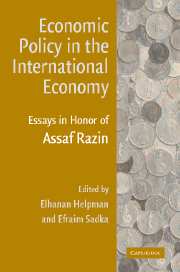Book contents
- Frontmatter
- Contents
- List of Contributors
- Preface
- Introduction
- PART ONE FINANCIAL ISSUES IN OPEN ECONOMIES: THEORY
- PART TWO FINANCIAL ISSUES IN OPEN ECONOMIES: EMPIRICS
- PART THREE ECONOMIC GROWTH: THEORY AND EMPIRICS
- PART FOUR PUBLIC ECONOMICS
- 11 Simulating Fundamental Tax Reform in the United States
- 12 The International Macroeconomics of Taxation and the Case against European Tax Harmonization
- 13 Home Bias in Portfolios and Taxation of Asset Income
- 14 Social Dumping in the Transformation Process?
- PART FIVE POLITICAL ECONOMY
- Author Index
- Subject Index
13 - Home Bias in Portfolios and Taxation of Asset Income
Published online by Cambridge University Press: 03 November 2009
- Frontmatter
- Contents
- List of Contributors
- Preface
- Introduction
- PART ONE FINANCIAL ISSUES IN OPEN ECONOMIES: THEORY
- PART TWO FINANCIAL ISSUES IN OPEN ECONOMIES: EMPIRICS
- PART THREE ECONOMIC GROWTH: THEORY AND EMPIRICS
- PART FOUR PUBLIC ECONOMICS
- 11 Simulating Fundamental Tax Reform in the United States
- 12 The International Macroeconomics of Taxation and the Case against European Tax Harmonization
- 13 Home Bias in Portfolios and Taxation of Asset Income
- 14 Social Dumping in the Transformation Process?
- PART FIVE POLITICAL ECONOMY
- Author Index
- Subject Index
Summary
There is now extensive evidence that individual investors have a strong tendency to invest in domestic rather than foreign equity. This “home bias” in portfolios can potentially have important implications for economic behavior and economic policy. For one, it suggests that extra savings in a country will be invested primarily at home, consistent with the evidence for a lack of international capital mobility reported in Feldstein and Horioka (1980). In addition, the implied lack of capital mobility may explain the observed taxation of the return to domestic capital. In particular, when capital is fully mobile internationally a tax on domestic capital in a small country does not affect the net-of-tax rate of return available to capital owners and instead would be borne by immobile factors, primarily labor. In this setting, Diamond and Mirrlees (1971) show that such a tax would be dominated by labor income taxes (or consumption taxes) even from the perspective of workers. If capital were not so mobile, however, then capital should bear part of the tax, so that the tax might well be chosen for distributional reasons.
These presumed implications of home bias can be judged, however, only in the context of some particular model that generates home bias. The objective of this paper is to choose a plausible explanation for the observed home bias, and then to use a formal model based on this explanation to explore whether the above two implications of home bias necessarily follow.
- Type
- Chapter
- Information
- Economic Policy in the International EconomyEssays in Honor of Assaf Razin, pp. 371 - 404Publisher: Cambridge University PressPrint publication year: 2003

